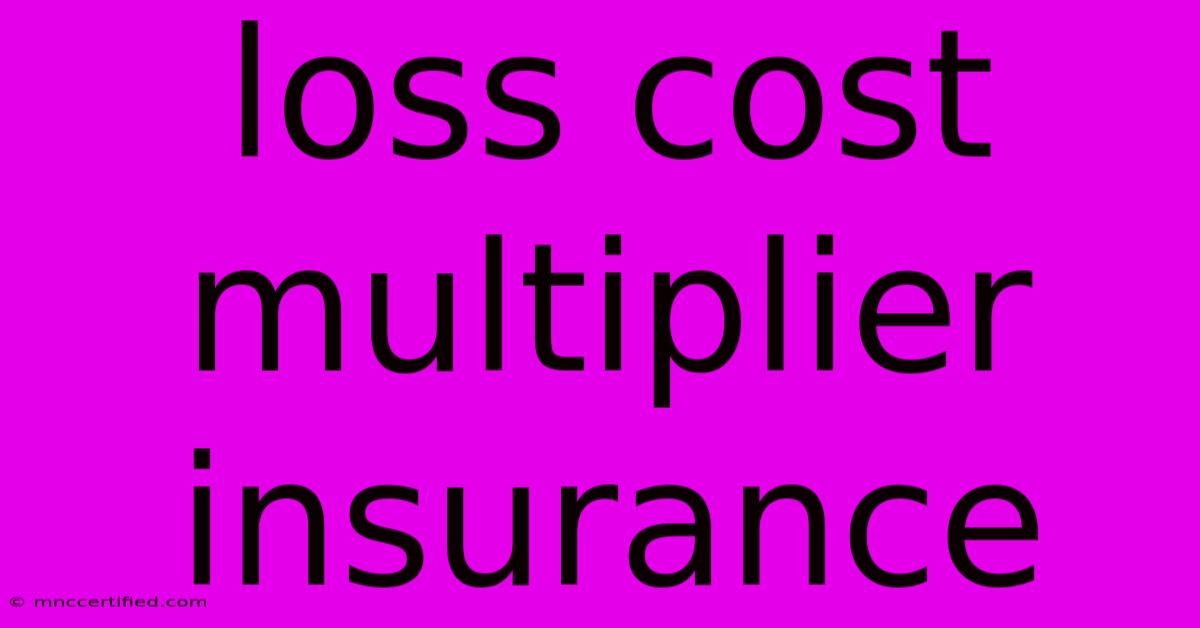Loss Cost Multiplier Insurance

Table of Contents
Decoding the Loss Cost Multiplier: A Comprehensive Guide to Insurance Pricing
Understanding how your insurance premiums are calculated can feel like navigating a maze. One crucial element often shrouded in mystery is the Loss Cost Multiplier (LCM). This seemingly simple number significantly impacts your insurance costs, making it vital for both consumers and insurance professionals to grasp its meaning and implications. This guide provides a comprehensive overview of the LCM, explaining its components, how it's used, and how it affects your insurance premiums.
What is a Loss Cost Multiplier (LCM)?
The Loss Cost Multiplier is a factor used by insurance companies to determine the final premium for an insurance policy. It represents the amount added to the base loss costs to account for expenses, profits, and taxes. In simpler terms, it's the markup on the actual cost of claims (loss costs). Think of it as the percentage added to cover the insurer's operational costs and ensure profitability. A higher LCM means higher premiums.
Key Components of the LCM
The LCM isn't a random number; it's carefully calculated, incorporating several key factors:
- Loss Costs: This is the core component representing the insurer's projected cost of claims for a specific risk. These are based on historical data, statistical modeling, and actuarial analysis. Factors influencing loss costs include claims frequency and severity.
- Expenses: This portion covers the insurer's operational expenses, including salaries, marketing, administrative costs, and technology investments. Efficient operations lead to lower expenses and, consequently, a lower LCM.
- Profits: Insurance companies need to generate profit to remain viable. This component ensures a reasonable return on investment for shareholders.
- Taxes: Various taxes and assessments levied on insurance companies are also factored into the LCM. These vary depending on location and regulatory environment.
How the LCM Impacts Your Premiums
The LCM is applied to the base loss costs to arrive at the final premium. The formula is straightforward:
Premium = Loss Costs x Loss Cost Multiplier
For example, if the base loss costs for a specific policy are $500, and the LCM is 1.5, the final premium will be $750 ($500 x 1.5). A higher LCM directly translates to higher premiums for policyholders.
Factors Influencing the LCM
Several factors can influence the LCM, making it dynamic and subject to change:
- Competition: In a highly competitive insurance market, companies may have a lower LCM to attract more customers.
- Regulatory Environment: Changes in regulations and taxes can affect the expense component of the LCM.
- Economic Conditions: Inflation and economic downturns can impact both loss costs and expenses.
- Risk Assessment: The inherent risk associated with insuring a particular individual or business directly impacts the loss costs and, in turn, the LCM. Higher risk profiles usually translate to higher premiums.
Understanding Your LCM: A Consumer Perspective
While you might not see the exact LCM on your insurance policy, understanding its role is crucial for making informed decisions. By comparing quotes from different insurers, you can indirectly assess the competitiveness of their LCMs. Factors like policy features, discounts, and customer service should be considered alongside premium costs.
LCM and the Insurance Industry
For insurance professionals, understanding the LCM is vital for pricing strategies, underwriting, and risk management. Accurate LCM calculations ensure profitability while maintaining competitive premiums. Analyzing historical data, anticipating future trends, and implementing efficient operational processes are all key to managing the LCM effectively.
Conclusion: Navigating the Numbers
The Loss Cost Multiplier is a critical component in determining insurance premiums. While its complexity might seem daunting, understanding its basic principles empowers both consumers and industry professionals to make informed decisions, manage risk effectively, and navigate the world of insurance pricing with greater clarity. By focusing on the underlying components and their influence, you can gain a stronger grasp of this essential aspect of insurance.

Thank you for visiting our website wich cover about Loss Cost Multiplier Insurance. We hope the information provided has been useful to you. Feel free to contact us if you have any questions or need further assistance. See you next time and dont miss to bookmark.
Featured Posts
-
Georgia Claims 10 000 Mega Millions Prize
Nov 27, 2024
-
Walmart Rolls Back Dei Initiatives
Nov 27, 2024
-
Morgan Freeman 87 Spotted In La
Nov 27, 2024
-
This Day In History November 27th
Nov 27, 2024
-
Live Updates Elizabeth Line Service Halted
Nov 27, 2024